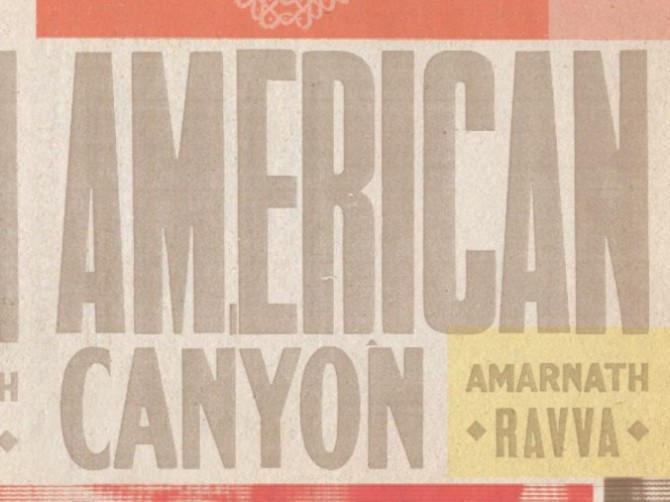We interviewed Amarnath Rava about his debut book, American Canyon. He talks about being part of the Indian diaspora, the meaning behind the title, and other Indian American literature.
Kaya Press: What inspired you to write American Canyon? What do you want your readers to take away from this book?
Amarnath Ravva: In my twenties, I had the blessing to experience and learn about Maidu [Northern California indigenous] culture because of one of my friends, Dena Cunningham, and her brother, Farrell Cunningham. Both were heavily invested in reviving the traditions of their ancestors, and Farrell, who passed away recently, was one of the few people of his generation fluent in Mountain Maidu. They invited me to participate in the Bear Dance every summer and told me the stories of their people. They took me to the places sacred to them, and the stories behind those places.
I found an unexpected kinship in the Sierras, and I began to wonder about myself, began to wonder what it meant to be a part of the Indian diaspora. Dena and Farrell showed me the importance of an individual, specific, and unique apprehension of one’s cultural heritage. In their case, this was even more important because of how endangered the Mountain Maidu culture has become. I wanted to know, for myself, what my own cultural heritage consisted of, as it was told by my family and ancestors. Not the one that I had read in books, but the one that persists in local traditions and utterances. So I worked for Charles Schwab for a year, saved enough money to go to India, and spent a summer with both sides of my family and documented their stories. If there is something for a reader to take away, it is that one person’s vision of the world and who they are is as important as any other—cultural loss happens one person at a time.
KP: How did you come to decide on the title American Canyon?
AR: When I was [in the MFA program] at CalArts, working on my manuscript, it was originally called “Naga Prathista” or snake ritual. At the time, I was also working on a video installation—a miniature replica of my parents’ house in the Bay Area suburb of American Canyon—and I had a miniature video screen of red rock canyon walls zoomed up close and continually panning in a falling motion on the wall of one of the model’s rooms. I wanted to represent the many layers of history beneath our feet, both metaphorically and physically, that we are unaware of. The problem with “Naga Prathista” was that it seemed too esoteric, and one of my advisors, Janet Sarbanes, suggested I title the book “American Canyon.” Not only does it speak to my parents’ actual home, which plays a role in the book, but it also suggests the metaphor or image of a distinct and long unknown history here beneath our feet. I don’t think we live in the “New World.” We live in a very old part of the world, as old as any other part of it.
KP: Which came first: the images or the text? How did you choose all of the separate mediums — photos, video logs, etc.– that you used to tell your story?
AR: I would say that both came first. In my twenties, the younger version of myself read all of Remembrance of Things Past by Marcel Proust one spring. Proust taught me that our recollection, or memory, of events in our life is fictional. For a couple of years at that point I had casually been writing about my family and my experiences in India—first, in a zine that I illegally distributed in high school, and then later in the form of poems and short stories.
My understanding of what Proust was asserting in the 1920s became all too palpable when I re-watched old Hi-8 video I had shot in India when I was fourteen. The images and events were very different from my recollection of India, and my recollection of myself. I had two very discordant images of my own experience—the one in my texts and the one I had shot.
Of course, we would like the video or the photograph to be the dominant medium. But it is equally suspect—we frame, choose, and compose a specific sliver of our reality. I went back to India again the next summer and attempted to recreate the video I had lost from the texts that I had written that year. It proved impossible, and proved that both mediums were equally imaginary. The book, as it is, tries to force that issue by intertwining all of the various moments I documented. Each variance in technique [super8 film, video documentation, or time-lapse] all have at their basis a manipulation of time. Which is what writing does as well. It manipulates time; it makes something past become present.
KP: You write a book about the duality of being both Indian and American, yet your book is so different from the work of other Indian American authors, such as Jhumpa Lahiri. Did you think about the Indian American canon when you were writing, or did your idea for American Canyon develop outside of the dialogue on Asian American literature?
AR: I hope that every person is different and has a unique vision of the world. From what I understand about Hinduism, which is mine and may not be accurate at all, one of its driving forces 7,000 years ago or so was to unite a plethora of local practices, languages, texts, rituals, cultures, and gods under one monolithic roof. Shiva suddenly is one god with a million names, not just one god among a million others. I would say that the distinction between cultural/religious stories and the stories of my own family is faulty; all stories are traditional and cultural. Some become more dominant and adopted than others. My grandmother’s version of a traditional story is more important to me than the canonical one, because it explains who I am more accurately. It is the story l know. So my answer for this question is similar; I’m not typical, I am who I am; I am not breaking a mold, because there is no mold; I hope that what I say is in dialogue with whoever cares to listen.


Leave a Comment
We'd love to know what you think.